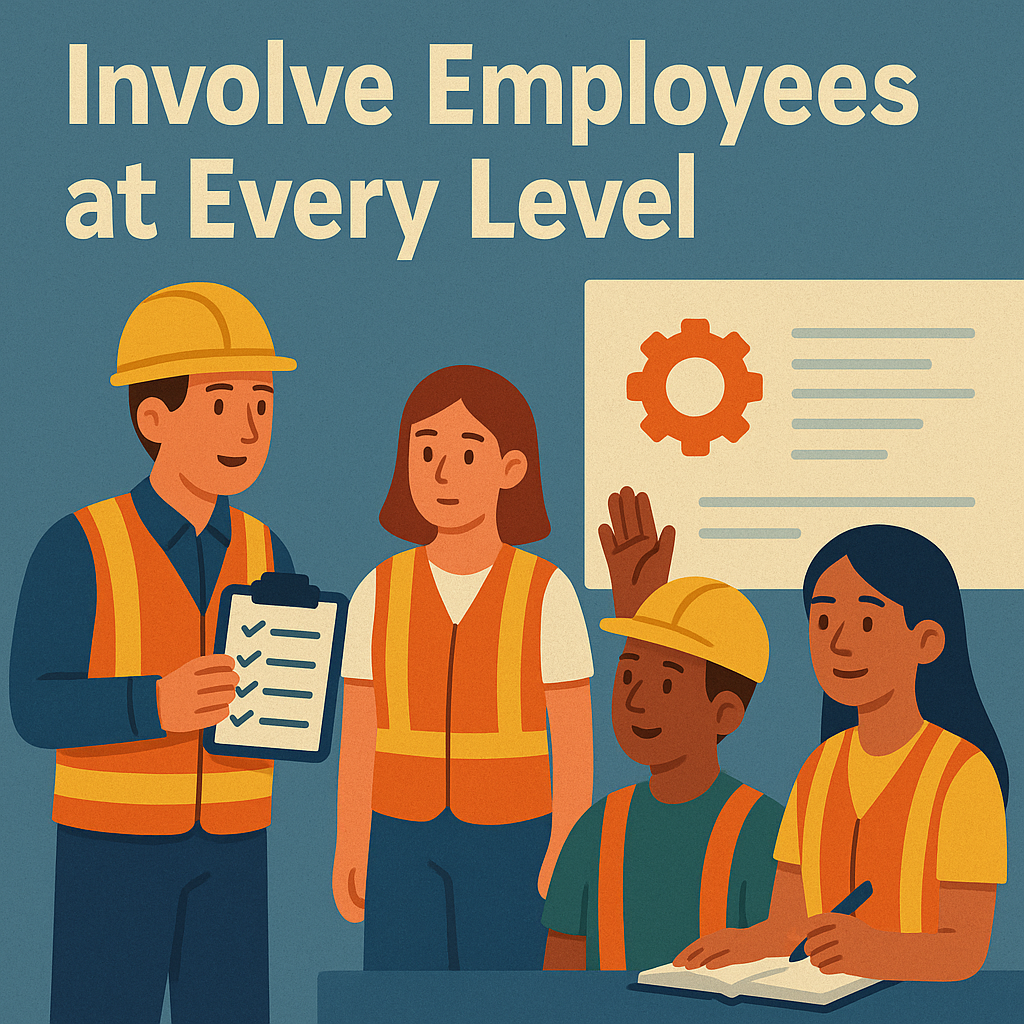A strong Workplace Safety Culture is more than policies and posters—it’s about the shared mindset that safety is everyone’s responsibility. Organizations that prioritize safety not only reduce accidents but also boost morale, retention, and productivity…

If you’re wondering how to develop a workplace safety culture that lasts, this article provides a step-by-step guide supported by proven strategies and real-world applications.
- What Is Workplace Safety Culture?
- Why It Matters
- 1. Get Buy-In from Leadership
- 2. Define and Communicate Safety Values
- 3. Involve Employees at Every Level
- 4. Train and Educate Continuously
- 5. Reinforce with Positive Recognition
- 6. Create a Safe Space for Reporting
- 7. Learn from Near Misses and Incidents
- 8. Make Safety Visible Every Day
- 9. Audit, Improve, Repeat
- 10. Link Safety to Purpose and People
- Conclusion
What Is Workplace Safety Culture?
Workplace safety culture refers to the attitudes, beliefs, and behaviors that shape how safety is prioritized and practiced in an organization. It’s reflected in:
- How leaders act and communicate about safety
- How employees report hazards or near-misses
- How consistently safety procedures are followed
- How mistakes and incidents are handled
It’s not what’s written in the manual—it’s how people live it daily.
Why It Matters
A lasting safety culture:
✅ Reduces injury and illness rates
✅ Improves compliance with OHSA/OSHA standards
✅ Builds trust between workers and management
✅ Enhances your organization’s reputation
✅ Cuts costs from lost time and compensation claims
Organizations like WorkSafeBC and OHSE.ca emphasize culture as a key indicator of long-term safety success.
1. Get Buy-In from Leadership
Culture begins at the top. Leaders must be the role models of safety. Without visible and consistent commitment from management, any effort to build culture will fail.
Ways to show commitment:
- Include safety in KPIs and performance reviews
- Attend toolbox talks and inspections
- Respond quickly to safety concerns raised by staff
- Invest in updated PPE and equipment
- Prioritize safety over productivity when needed
Internal link: Read our article on Top 10 Daily Habits That Make Workplaces Safer
2. Define and Communicate Safety Values
Every organization should define a clear safety mission and vision. These must be:
- Simple and understandable
- Visible in the workplace (e.g., posters, meetings)
- Reinforced regularly in communication
Include safety goals and commitments in onboarding documents, annual meetings, and company handbooks.
3. Involve Employees at Every Level
True culture is built together—not handed down.

Empower your team by:
- Encouraging hazard reporting without fear of punishment
- Involving workers in risk assessments and inspections
- Asking for feedback on safety procedures
- Recognizing safety suggestions and improvements
Consider creating a Joint Health and Safety Committee (JHSC) that includes diverse voices across departments.
4. Train and Educate Continuously
Safety training should never be a one-time event. Make learning part of your culture:
- Monthly refresher sessions
- Microlearning or safety quizzes
- Role-specific training (e.g., for forklift or lab work)
- First aid, fire extinguisher, or WHMIS certifications
Training empowers employees to take ownership of their environment and decisions.
5. Reinforce with Positive Recognition
Recognize safe behaviors, not just compliance. Examples include:
- “Safety Star of the Month” awards
- Team shoutouts during meetings
- Small incentives for incident-free periods
- Celebrating improvement milestones
Positive reinforcement makes safety personal and rewarding—not just a rule.
6. Create a Safe Space for Reporting
Many incidents go unreported due to fear. Combat that by:
- Making reporting simple (QR code, app, or box)
- Responding quickly and respectfully to concerns
- Anonymizing submissions if needed
- Communicating follow-ups and actions taken
The goal is to normalize speaking up—because silence isn’t safe.
7. Learn from Near Misses and Incidents
Every event—especially near misses—is a learning opportunity.

Instead of blame:
- Conduct root cause investigations
- Share lessons learned (without names)
- Adjust procedures and communicate changes
- Involve staff in solution building
Failure to act on incidents erodes trust and signals that safety isn’t truly valued.
8. Make Safety Visible Every Day
Visibility keeps safety top-of-mind. Try:
- Morning safety huddles
- Safety message boards
- Monthly themes (e.g., “Slip, Trip, Fall Awareness”)
- PPE reminder signage
Use humor, visuals, and employee-generated content to keep it fresh.
9. Audit, Improve, Repeat
A lasting culture evolves. Measure it regularly through:
| Metric | Frequency |
|---|---|
| Safety observations | Weekly |
| Near-miss reports | Monthly |
| Incident trends | Quarterly |
| Employee safety perception survey | Biannually |
Use the results to adjust training, policies, and communication. Let staff know how their feedback drives change.
10. Link Safety to Purpose and People
The most powerful motivator for safe behavior is not rules—it’s people. Frame safety in terms of:
- Going home to family
- Protecting coworkers
- Building a respectful, caring workplace
- Avoiding preventable suffering
Make it human. Make it real.
Conclusion
Creating a lasting Workplace Safety Culture takes time, consistency, and heart. It’s not about checking boxes—it’s about inspiring daily actions that protect lives.
With leadership commitment, employee engagement, and continuous improvement, safety can become more than a policy. It becomes who you are as an organization.

No comments yet